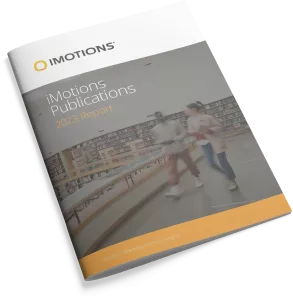-
Multimodal Validation of Facial Expression Detection Software for Real-time Monitoring of Affect in Patients with Suicidal Intent
Abstract: Facial expression is an independent and objective marker of affect. Basic emotions (fear, sadness, joy, anger, disgust and surprise) have been shown to be universal across human cultures. Techniques such as the Facial Action Coding System can capture emotion with good reliability. Such techniques visually process the changes in different assemblies of facial muscles that produce […]
-
Impairments in face discrimination and emotion recognition are related to aging and cognitive dysfunctions in Parkinson’s disease with dementia
Patients with Parkinson’s disease (PD) suffer from motor and non-motor symptoms; 40% would develop dementia (PD-D). Impaired face and emotion processing in PD has been reported; however, the deficits of face processing in PD-D remain unclear. We investigated three essential aspects of face processing capacity in PD-D, and the associations between cognitive, neuropsychiatric assessments and […]
-
Andante, Allegro o Silenzio: An Examination of Background Music Tempo on Facial Emotions, Electrodermal Responses, and Reading Task Performance
Current literature has established that learner’s emotions are an integral part of the learning experience (Pekrun & Perry, 2014) and have significant effects on learning processes that optimize performance (Cunningham, Dunfield, & Stillman, 2013), and attentional responses (Kärner & Kögler, 2016). This present study examines the psychoemotional and psychophysiological effects that variations in the tempo […]
-
Arousing the audience: The two-peak structure of drama film trailers
Film trailers are considered the most important marketing tool for a feature film; however, they have rarely been discussed in audience research. This article examines audiences’ emotional responses to film trailer content based on an exploratory study using skin conductance to measure emotional arousal as well as self-reports on recall, evaluation and the desire to […]
-
Comparing the Affectiva iMotions Facial Expression Analysis Software with EMG
Abstract: People’s faces display emotions, informing others about their affective states. In order to measure facial displays of emotion, Electromyography (EMG) has widely been used, requiring electrodes and technical equipment. More recently, emotion recognition software has been developed that detects emotions from videos. However, its validity and comparability to EMG is unclear. The aim of […]
-
A Comparison of the Affectiva iMotions Facial Expression Analysis Software With EMG for Identifying Facial Expressions of Emotion
Human faces express emotions, informing others about their affective states. In order to measure expressions of emotion, facial Electromyography (EMG) has widely been used, requiring electrodes and technical equipment. More recently, emotion recognition software has been developed that detects emotions from video recordings of human faces. However, its validity and comparability to EMG measures is […]
-
Eye gaze and facial displays of emotion during emotional film clips in remitted patients with bipolar disorder
Aberrant emotional reactivity is a putative endophenotype for bipolar disorder (BD), but the findings of behavioral studies are often negative due to suboptimal sensitivity of the employed paradigms. This study aimed to investigate whether visual gaze patterns and facial displays of emotion during emotional film clips can reveal subtle behavioral abnormalities in remitted BD patients. Thirty-eight […]
-
A Visual Attentive Model for Discovering Patterns in Eye-Tracking Data—A Proposal in Cultural Heritage
In the Cultural Heritage (CH) context, art galleries and museums employ technology devices to enhance and personalise the museum visit experience. However, the most challenging aspect is to determine what the visitor is interested in. In this work, a novel Visual Attentive Model (VAM) has been proposed that is learned from eye tracking data. In […]
-
Mobile and stationary eye tracking comparison – package design and in-store results
Abstract: Purpose This paper aims to test the similarity of the results of on-screen eye tracking compared to mobile eye tracking in the context of first fixation location on stimuli. Design/methodology/approach Three studies were conducted altogether with 117 participants, where the authors compared both methods: stationary eye tracking and mobile eye tracking. Findings The studies […]
-
Affect and exertion during incremental physical exercise: Examining changes using automated facial action analysis and experiential self-report
Abstract: Recent research indicates that affective responses during exercise are an important determinant of future exercise and physical activity. Thus far these responses have been measured with standardized self-report scales, but this study used biometric software for automated facial action analysis to analyze the changes that occur during physical exercise. A sample of 132 young, […]
Research Report 2023
In-depth look at the scientific landscape as powered by iMotions software, showcasing groundbreaking research and the impact of our tools in various scientific and industrial fields.

Share Your Research

850+ universities worldwide with an iMotions human behavior lab
73 of the top 100 highest ranked universities
710+ published research papers using iMotions
iMotions is used for some of the most interesting human behavior research studies carried out by top researchers around the world. Contact us to have your publication featured here.
The authors of these publications have used iMotions as a software tool within their research.
“Software should be cited on the same basis as any other research product such as a paper or a book; that is, authors should cite the appropriate set of software products just as they cite the appropriate set of papers” (Katz et al., 2020).
We therefore encourage you to cite the use of iMotions where appropriate.
How to cite iMotions
APA
iMotions (10), iMotions A/S, Copenhagen, Denmark, (2024).
Note: adjust the version and year where relevant.
5 Most Popular Blogs
Learn How to Conduct Human Behavior Research with iMotions
Publications
Read publications made possible with iMotions
Blog
Get inspired and learn more from our expert content writers
Newsletter
A monthly close up of latest product and research news





